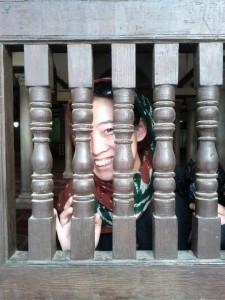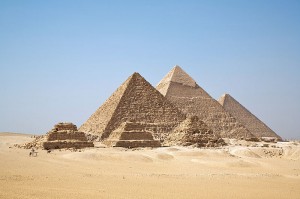Nobuko, my friend and traveler, leaves her lasting impressions about the Egyptian desert. She is on her way to Amman/Jordan now.
Visiting the desert is truly my most favorite thing to do. I enjoy it more than beaches. The complete silence and the sky reaching from horizon to horizon, whichever way I look, make me feel so FREE like nothing else does.
From Dakhla to Bahariya, it takes 6 hours and 50 E pounds by bus. I wish I could have travelled during the day to enjoy the scenery, but due to the time crunch my underestimation had created, I had to take a bus at 5pm. So I only had 1 hour to see the landscape. About the depressed tourism situation, I had reported earlier.
But things must be worse than I can see, because many hotels in Bahariya, the most visited oasis in the western oasis area, have disconnected their phones or do not answer the phone. Among the ones that are still operating, Desert Safari Home was the budget choice at 50 E pounds per night for a single room. The son of the owner, Mohammed, picked me up at the bus station at 11:30pm. The owner Mr. Badr received me at the hotel, but I was too tired to chat.
The next morning I learned that there was another guest there!! In Luxor and Dakhla, I was the only guest. I was very happy to have company, and possibly being able to go on an overnight desert trip and share the cost with this person. If you are alone, the price for a two-day trip costs a whopping 700 E pounds. But with two people, the price per person drops to 400 E pounds.
The other guest was a Spanish woman my age, she also has been traveling alone for one year. And thankfully we hit it off! I tried to convince her to do a three-day trip with me, but due to financial reason, we settled on the two-day trip. Really, the more people, the cheaper when you travel. The more people you have with you, the better your chance of succeeding in bargaining on prices of room and transportation (you can even hire an entire vehicle!). You can also share the cost to hire a driver / guide.
That day we took it easy and only did a mini tour for two hours (35 E pounds per person). The excursion was short, but high was its intensity, because we had to go across many sand dunes. The driver, Sahid, is a Bedouin who looks like a “gangsta” with his sunglasses on. But he becomes like a small child with complete sweetness when he smiles. He agreed in good humor when I made him pose with me for a photo of us looking like two mean “gangsta”!
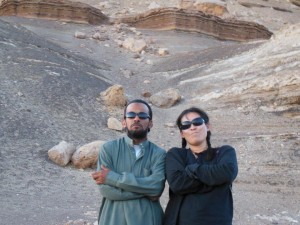
Driving over sand dunes is not an easy fleet. One must have the ability to gauge how much momentum or control is needed to go up/down the dunes without getting stuck or flipping the jeep over, and the skills to deliver the calculated maneuvers. He was more than competent because he drove it like he was playing in a sand box with his mini car.
The next day, we headed out around 11am. We were so happy to have Sahid as our driver again. The first stop was the Black Desert. I was not so excited about this one, but oh boy, it is so beautiful there! The black volcanic rocks turned into black sand and it covers a vast area like powdered sugar sprinkled over a pound cake, creating a gradation of color shift from brown to black.
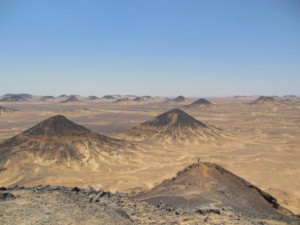
Black Desert in Egypt
Because of this effect, you can see even the most subtle sand waves created by the desert wind which go on for miles. Wow. No eye catching frills, only the simple tone gradations of two colors. But because of this simplicity and the vastness of the view, it’s a painting done by nature on the largest canvas, and to me, it is far more moving and beautiful than famous pieces in any given museum.
After lunch and a few more stops, we reached the White Desert – another incredible landscape. It looks like thousands of odd shaped pieces of white growth are sticking out of the desert floor which itself is also largely white with patches of brown sand. Upon getting off the jeep, I realized that the desert floor of this area is actually entirely white, if all the sand was swept off.
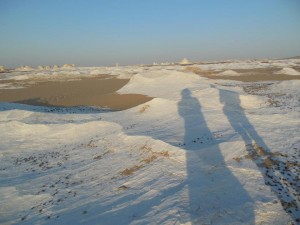
White Desert in Egypt
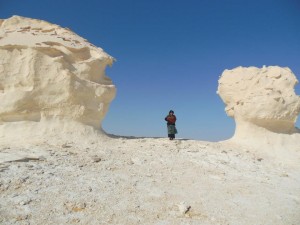

Nobuko in the White Desert, Egypt
Its color is evidence that the area was once a sea bed and the desert floor contains salt. We walked around while Sahid set up camp and cooked for us. We found so many sea shells – in their original shape and still intact – on the ground. The white “rocks” looked like cloud patches and the white ground shaped like waves by the continuous winds. It made me feel as if I was walking on the surface of the ocean, or in the sky.
Sahid is a great cook. He made a chicken – rice – vegetable dish. It sounds simple, but I have never had a chicken dish like that one before. And we enjoyed a bonfire, with a full stomach and the desert night sky, it was hypnotizing staring at the fire. Two foxes visited us to get the leftovers. They were so small! After they had their fill, they used our plastic cups for toys, and played with them for a long time without getting bored.
Our camp did not have a roof. Since it does not rain, and the wind was not strong, it was perfect. I fell asleep fast, but I was awakened when I felt through the blanket one of the foxes walking over my legs.
Sahid said there used to be as many as 35-40 groups coming to the White Desert to camp before the revolution when tourism was still booming. So the foxes must have gotten used to being around people. That night we were the only ones in the area, and we felt lucky to enjoy the quietness of the desert.
Edit: The photos were added on 14 May 2013.
